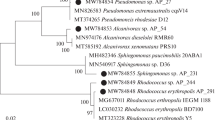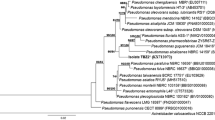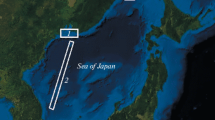Abstract
Cultured hydrocarbon-oxidizing bacteria have been isolated for the first time from bacterioplankton in urban Lake Beloye (Moscow). The taxonomic positions of two bacterial strains (2012B and 2012C) isolated from this lake have been determined. Lipids of the strain 2012B comprise C14:0–C19:0 fatty acids, the most abundant of them being C15:0 (54%), C16:0 (17%), C17:0 (10%), and 10-methyl С18:0 (3.5%). Lipids of the strain 2012C comprise C14:0–C19:0 fatty acids, the most abundant of them being C15:0 (45%), C16:0 (32%), and C17:0 (9%). A phylogenetic analysis of strain 2012B is performed using the nucleotide sequences of the 16S rRNA (KP779654.1) and alkB (KR422620.1) genes and the strain is identified as a typical member of the genus Rhodococcus spp. (Actinobacteria, Nocardiaceae). The combination of molecular identification and analysis of biochemical and physiological properties makes it possible to identify strain 2012B as Rhodococcusqingshengii 2012B. A phylogenetic analysis of strain 2012C is performed using the nucleotide sequences of 16S rRNA (MG966152) and shows the highest identity (99.57%) of strain 2012С with Pseudomonas psychrotolerans and Pseudomonas oryzihabitans





Similar content being viewed by others
REFERENCES
Akulova, A.Yu., Il’inskii, V.V., Mosharova, I.V., et al., Status of heterotrophic bacterioplankton of coastal areas of lakes Svyatoe and Beloe of the Koskinskii Natural-Historical Park (Moscow) in 2011, Izv. Samar. Nauchn. Tsentra Ross. Akad. Nauk, 2014, vol. 16, no. 1, p. 1185.
Altschul, S.F., Madden, T.L., Schaffer, A.A., et al., Gapped blast and psi-blast: a new generation of protein database search programs, Nucleic Acids Res., 1997, vol. 25, no. 17, p. 3389.
van Beilen, J.B. and Funhoff, E.G., Alkane hydroxylases involved in microbial alkane degradation, Appl. Microbiol. Biotechnol., 2007, vol. 74, p. 13.
Bergey, D.H., Krieg, N.R., and Holt, J.G., Bergey’s Manual of Systematic Bacteriology, Baltimore, MD: Williams and Wilkins, 1989, vol. 4, p. 2648.
Brooijmans, R.J.W., Pastink, M.I., and Siezen, R.J., Hydrocarbon-degrading bacteria: the oil-spill clean-up crew, Microb. Biotechnol., 2009, vol. 2, no. 6, p. 587.
Cameotra, S.S. and Singh, P., Bioremediation of oil sludge using crude biosurfactants, Int. Biodeterior. Biodegrad., 2008, vol. 62, p. 274.
Chernyavskaya, M.I., El’gammudi, A.A., and Titok, M.A., The primary characteristic of oil-degrading bacteria, Vestn. Beloruss. Gos. Univ., 2012, vol. 2, no. 3, p. 44.
Das, N. and Chandran, P., Microbial degradation of petroleum hydrocarbon contaminants: an overview, Biotechnol. Res. Int, 2011, vol. 2011, p. 13.
Felsenstein, J., Confidence limits on phylogenies: an approach using the bootstrap, Evolution, 1985, vol. 39, p. 783.
Fredriksson, N.J., Hermansson, M., and Wilén, B.-M., The choice of PCR primers has great impact on assessments of bacterial community diversity and dynamics in a wastewater treatment plant, PLoS One, 2013, vol. 8, no. 10.
Hansen, J. and Moller, I., Percolation of starch and soluble carbohydrates from plant tissue for quantitative determination with anthrone, Anal. Biochem., 1975, vol. 68, p. 87.
Huber, T., Faulkner, G., and Hugenholtz, P., Bellerophon: a program to detect chimeric sequences in multiple sequence alignments, Bioinformatics, 2004, vol. 20, p. 2317.
Kimura, M., A simple method for estimating evolutionary rate of base substitutions through comparative studies of nucleotide sequences, J. Mol. Evol., 1980, vol. 16, p. 111.
Kohno, T., Sugimoto, Y., Sei, K., and Mori, K., Design of PCR primers and gene probes for general detection alkane-degrading bacteria, Microbiol. Environ., vol. 17, no. 3, p. 114.
Koksharova, O., Shubert, M., Shestakov, S., and Cerff, R., Genetic and biochemical evidence for distinct key functions of two highly divergent gapdh genes in catabolic and anabolic carbon flow of the cyanobacterium Synechocystis sp., Plant. Mol. Biol., 1998, vol. 36, p. 183.
Kumar, S., Stecher, G., Li, M., et al., MEGA X: molecular evolutionary genetics analysis across computing platforms, Mol. Biol. Evol., 2018, vol. 35, p. 1547.
Kuznetsov, S.I., Rol’ mikroorganizmov v krugovorote veshchestv v ozerakh (Role of Microorganisms in the Turnover of Substances in Lakes), Moscow: Nauka, 1952.
Kuznetsov, S.I., Mikroflora ozer i ee geokhimicheskaya deyatel’nost' (The Microflora of Lakes and Their Geochemical Activity), Leningrad: Nauka, 1970.
Long, G.R., Ayers, M.A., Callender, E., and Van Metre, P.C., Trends in chemical concentration in sediment cores from three lakes in New Jersey and one lake on Long Island, New York, U.S., in Geological Survey, Water-Res. Inv. Rep., 2003, vol. 02-4272, p. 32.
Mills, A.L., Breule, C., and Colwell, R.R., Enumeration of petroleum-degrading marine and estuarine microorganisms by the most probable number method, Can. J. Microbiol., 1978, vol. 24, p. 552.
Ravikumar, P., Mehmood, M.A., and Somashekar, R.K., Water quality index to determine the surface water quality of Sankey tank and Mallathahalli lake, Bangalore urban district, Karnataka, India, Appl. Water Sci., 2013, vol. 3, no. 1, p. 247.
Rossolimo, L.L., Morphometry of Kosino lakes, Tr. Limnol. St. Kosine, 1925, no. 2, p. 3.
Safronova, N.A. and Koksharova, O.A., Bakteriya Rhodococcus sp.—potentsial’nyi destruktor detonatsionnykh nanoalmazov, Ross. Nanotekhnol., 2018, nos. 7–8, p. 88.
Saitou, N. and Nei, M., The neighbor-joining method: a new method for reconstructing phylogenetic trees, Mol. Biol. Evol., 1987, vol. 4, p. 406.
Sambrook, J., Fritsch, E.F., and Maniatis, T., Molecular Cloning: A Laboratory Manual, New York: Cold Spring Harbor Laboratory Press, 1989.
Sasser, M., Identification of bacteria by gas chromatography of cellular fatty acids, MIDI Technical Note 101, 2001.
Stackebrandt, E., Molecular taxonomic parameters, Arch. Microbiol., 2011, vol. 32, p. 59.
Wang, Z., Xu, J., Li, Y., et al., Rhodococcus jialingiae sp. nov., an actinobacterium isolated from sludge of a carbendazim wastewater treatment facility, Int. J. Syst. Evol. Microbiol., 2010, vol. 60, p. 378.
Widmer, F., Seidler, R.J., Gillevet, P.M., et al., A highly selective PCR protocol for detecting 16S rRNA genes of the genus Pseudomonas (sensu stricto) in environmental samples, Appl. Environ. Microbiol., 1998, vol. 64, no. 7, p. 2545.
Xu, J.L., He, J., Wang, Z.C., et al., Rhodococcus qingshengii sp. nov., a carbendazim-degrading bacterium, Int. J. Syst. Evol. Microbiol, 2007, vol. 57, p. 2754.
ACKNOWLEDGMENTS
We thank R.A. Sidorov (Institute of Plant Physiology, Russian Academy of Sciences) for assistance in determining the fatty acid composition.
Funding
This work was performed as part of the project “Physiological Ecology of Microorganisms of Aquatic Ecosystems” (State Order No. AAAA-A16-116021660041-4).
Author information
Authors and Affiliations
Corresponding author
Ethics declarations
The authors declare that they have no conflict of interest. This article does not contain any studies involving animals or human participants performed by any of the authors.
Additional information
Translated by E. Makeeva
Abbreviations: PCR, polymerase chain reaction; HOB, hydrocarbon-oxidizing bacteria
Rights and permissions
About this article
Cite this article
Kravzova, T.R., Ilinsky, V.V., Lazebnaya, I.V. et al. Hydrocarbon-Oxidizing Bacteria from Urban Lake Beloye (Moscow): Identification and Phylogenetic Analysis. Inland Water Biol 13, 178–185 (2020). https://doi.org/10.1134/S1995082920020236
Received:
Revised:
Accepted:
Published:
Issue Date:
DOI: https://doi.org/10.1134/S1995082920020236




